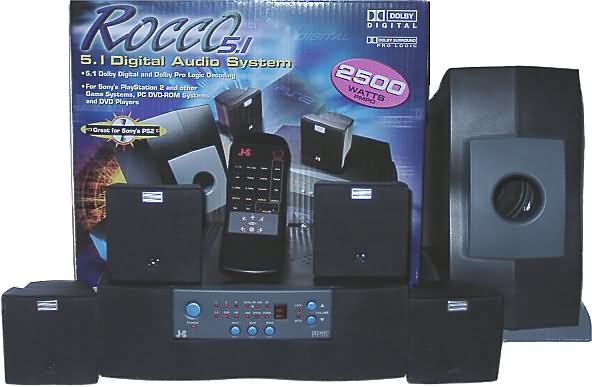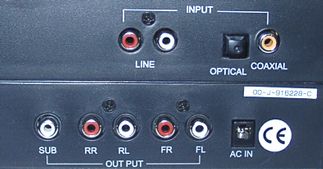 |
||
|
||
| ||
By Grigory
JAZZ Hipster Corporation is a well known Taiwanese company, one of the top manufacturers of multimedia acoustics produced under Jazz Speakers trademark. The company is both OEM*, and ODM** manufacturer. A top model in the 5.1 series of Jazz Speakers computer acoustic system with an integrated DD5.1 decoder is Rocco 5.1 Digital Audio System. This model will be a subject of the today's article. The company positions this product primarily for computers equipped with a DVD-ROM drive, home DVD players and game stations with a 5.1 channel digital output (for example, Sony PlayStation 2). * Original Equipment Manufacturer - produces equipment to order and under a trademark of third firms. ** Original Design Manufacturer - develops design, circuit technique etc. for third firms. Appearance
 The system is delivered in a traditionally decorated dark blue box. A box of decent dimensions turned to be unusually weighty. On opening we saw that a huge power supply unit takes a third of the whole weight. In the box of the Rocco 5.1 Digital Audio System you can find:
Amplifying and decoding unit (receiver)So, let us to start a detailed consideration of elements with a receiver.  In a 295x91x215 mm case there are two wideband speakers 2.5 inches in diameter, this is a clear advantage of the Rocco as compared with other 5.1 systems with a quiet center: for better comprehension of dialogs in DVD movies it is important for a volume level of a central channel to be comparable with a total volume level of front channels. A case of a receiver has a half-round rubber legs which provide a good acoustic isolation and prevents slipping down from the top of a monitor. On the front panel there is an electronic volume control, a decoder modes' switch and inputs' commutation. Besides, there are Mute and Power buttons. The decoder can work in three digital modes: Dolby Digital, Dolby Pro Logic and usual stereo. LEDs indicating working modes are also on a front panel.  On the rear panel of the central speaker there are:
 SubwooferA subwoofer's design is rather unusual.  Inside a 171 x 294 x 275 mm magnetic shielded case there is a 4" 20 W RMS speaker. A phase inverter hole is in the center of the sub. Below there are 4 rubber legs. On the side panels there are two rubber pads what allows to place the sub horizontally. The subwoofer is connected with an amplifying unit by a 2-meter cable. The length is enough to place the sub under a desk as many usually do. SatellitesThe total power of the system is 45 W (RMS), frequency ranges from 50 Hz to 20 KHz. Power of each satellite is 5 W (RMS). A diameter of a wideband speaker is 3 inches, the case measures 91 X 90 X 79 mm.  Look at the speaker's dimensions: it's undoubtedly not going to take much space on your computer desk. The satellite is connected to a receiver with cables long enough - 2 and 3 meters long (front and rear, correspondingly). In a place where a cable goes out of the case it is shielded in order not to fray. Power supply unitAs you know, proper power supply is very important for a good sound. I have already mentioned that a power supply unit is not light. Inside an adapter there is only a transformer which emits quiet buzzing. A consumed power of the unit is 75 W. The secondary winding gives an alternating voltage of 13 V, 5000 mA, 65 VA. It allows an amplifier to develop a power level sufficient to provide a high volume level.  Remote controllerA remote controller can't be called miniature - its dimensions are 60x15x160 mm. But it is compensated by a great deal of settings. The controller is powered from two AAA Dongguan Guangdong "Lonlife" batteries.  Some buttons duplicate those on the central speaker's control panel: Power, Mute, receiver's modes and volume control. With one button you can choose one of effect-processor modes (Theater, Hall, Stadium), decoder's modes (5.1 CH, Pro Logic, Stereo), inputs' commutation variant (Line, Optical, Coaxial). A Trim button allows to separate volume control of channels. The Test button allows you to check whether the speakers are connected by a byturn application of a noise signal. With a SPCFG button in Dolby Digital and Pro Logic decoding modes one can adjust a level of low frequency effects channel (LFE) in all speakers except the subwoofer. The C_Delay and S_Delay buttons are intended also only for DD 5.1 and Pro Logic modes. These settings allow to set a delay time for a central and rear channels: S_Delay - from 0 to 15 ms in 5 ms increments, and C_Delay - from 0 to 5 ms in 1 ms increments. In both cases 0 ms is set at default. Installation and connectionAn installation and a cable connection didn't cause any problems. In our opinion, the best layout of the system is when satellites are positioned at the level of listener's ears. The central speaker should be placed on the top of a monitor, but note that your monitor shouldn't overheat. This position makes control of an amplifying and decoding unit comfortable (without using a remote controller) and allows to position the central speaker right in the middle (according to format 5.1), not taking a keyboard off the table. Writings on cables near plugs notify what speaker is to be connected, it simplifies and speeds up the process o f connection of speakers to the receiver. Test system configuration:
On pressing a Power button you can hear a click typical for amplifiers. It means that the scheme is not properly thought out, and a sufficient delay for finishing transitions in the amplifier is missing. If you take one of the satellites close to your ear you will hear noise caused by an alternating current in an amplifying track. This can be justified only by the fact that a system block often makes greater noise than speakers do. TestsNow let's estimate the performance of the system. For this purpose we have listened to MP3 files with compositions of modern pop stars. It's silly to listen to classic collections on such an acoustic system considering dimensions of the speakers and the price. But even pop music sounds a bit flat. It seems that the speakers are short of power. Apparently it is caused by too small satellites' cases. An advantage is a lack of a plastic sounding what is typical for the majority of similar computer speakers. The next step is an estimation of a sound in DVD trailers rich in sound effects. Sound is quite decent, and usage of 2 speakers in a central channel made dialogs comprehensible. Unfortunately, even on a middle volume level not thick enough panels of the subwoofer started rattling. And at last there are games. The test was started with 3D shooters UT and Q3. As we expected the Rocco 5.1 performs quite well. In such games sound is initially of poor quality (11/22 KHz samples), that is why the better an acoustic system, the more distinct the artifacts will sound. In this case the system fulfilled its task quite good. As for hissing, I should note that it is difficult to estimate due to lack of a reference system, but still, the system is not that bad in this respect. In games with samples of higher quality (strategies, quests etc.) sound artifacts are clearer. Nevertheless, such sound will satisfy many PC users. ConclusionHighs of the Rocco 5.1 Digital Audio System:
Lows:
This system can be recommended for users who have
a sound card with a digital output (as well as for Sony PlayStation2
owners) and who want to get a decent system for DVD movies at not
a huge sum of money for an acoustic system with an integrated DD5.1
receiver.
Write a comment below. No registration needed!
|
Platform · Video · Multimedia · Mobile · Other || About us & Privacy policy · Twitter · Facebook Copyright © Byrds Research & Publishing, Ltd., 1997–2011. All rights reserved. |